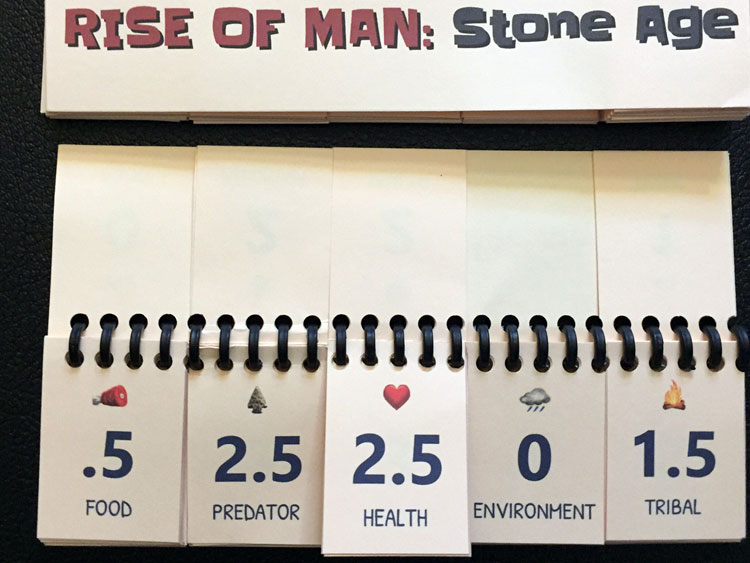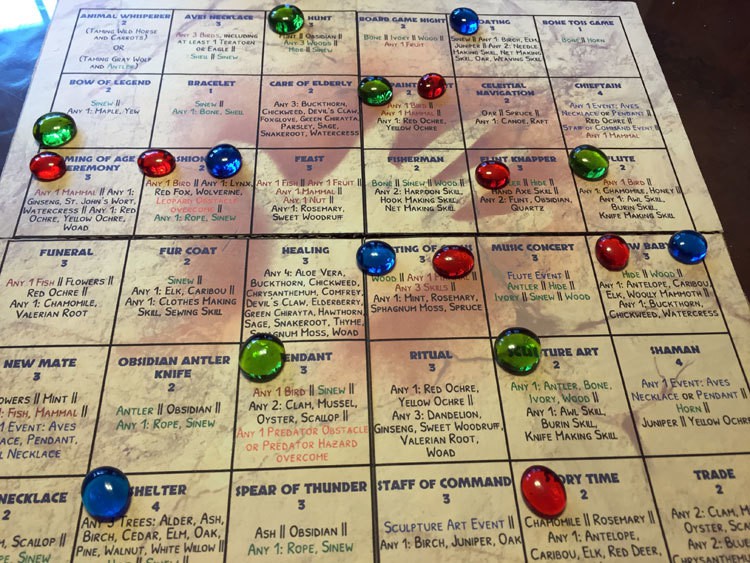Note: This preview uses pre-release components and rules. What you see here may be different from the final, published game.
 Like living in the Stone Age, Rise of Man: Stone Age challenges each player to survive the obstacles and hazards of everyday existence. At the same time they are continuing to improve the skill and overall sustainability of their tribe.
Like living in the Stone Age, Rise of Man: Stone Age challenges each player to survive the obstacles and hazards of everyday existence. At the same time they are continuing to improve the skill and overall sustainability of their tribe.
Rise of Man has just started it’s funding campaign on Kickstarter and is designed by Bryan Sloan. The game is being published by Black Forest Studio.
Game Overview

Rise of Man: Stone Age is a card drafting, strategy board game where players will vie for various resources that were indigenous to the Stone Age period. They do this in order to surmount the obstacles and hazards that are randomly drawn during a 5-round game. The game supports from 2-6 players and plays in about 30-90 minutes depending on player count.
How to Play
Each game concludes after 5 rounds and each round consists of 6 turns. Players start the game dealt either one obstacle or hazard card face up (In Round 3, players are dealt a combination of 2 obstacles or hazards.) The choice of taking an obstacle or hazard is left up to the player depending on how much confidence they have in fulfilling it.
Obstacles embody everyday challenges that Stone Age tribes were facing as they struggled to survive. Hazards are more difficult obstacles, but provide a greater reward in victory points if fulfilled. The players are also dealt 10 resource cards to begin each new round.

Players all play their turns simultaneously. On a player’s turn, the player performs one of the following actions:
- Play a Resource Card: This is the most common action a player will take. When this is done, the player increases the level of the appropriate section of their resource flipchart. The resources aid in overcoming obstacles and hazards as well as fulfilling the special events.
- Draw a Wild Card: The text on a wild card is followed immediately as it is drawn. Most wild cards provide a benefit to the player, but some have negative effects.
- Special Event Token Placement: If a player can fulfill the resource requirements of a special event, then they gain the victory points awarded by it. Each player can potentially complete up to 8 special events.
At the end of a turn, each player passes their remaining resource cards to the player on their left, except during round 3 when the cards are passed to the player to the right.
At the end of each round, each player determines if they have overcome their obstacle or hazard. To overcome them, they have to meet the accumulative resource levels shown on all of the cards displayed in front of them from round to round. If they have equal or more of the necessary resource levels on their resource flipcharts, then they have been successful and are rewarded with 2 victory points for an obstacle or 3 victory points for a hazard. If a player has failed to fulfill their obstacle or hazard, they receive a token that penalizes them 2 victory points.
At the end of 5 rounds, whichever player has garnered the most victory points wins the game.

Game Experience
During the first few play throughs of this game, it becomes obvious that there is much information to process in order to determine the best resource cards to play. Players need to both bolster the resource levels of your tribe to overcome the obstacles and hazards, and plan ahead to be able to play special events.
Due to the large amount of resource cards that accumulate in your tableau and the associated information overload, I was not able to clearly discern the path to victory. I can assure you that this is going to be the case for experienced gamers without a few games under their belt. Once you understand the importance of not passing on taking and playing certain types of resource cards, especially ones that are the prerequisite resources to play other resource cards, then that part of the game certainly becomes less daunting.

One aspect of the game that I found most challenging was determining which special events to satisfy as the game progressed. Some of the 2-point special events may fall into your lap based on the natural progression of what resource cards had to be played in order to overcome what randomly dealt obstacles and/or hazards I had to contend with from round-to-round.
Do I settle for those lower point special events or do I attempt to go after the more lucrative ones? That was a question that was always plaguing me. I determined that being opportunistic and staying flexible were my best options. At games with 3 or more players, the correct reply might be to play the special event when available and not dally around with the decision.
Rise of Man offers risk-reward gameplay options that I found thematic and thought-provoking. Even though on most of your turns you will play a resource card from your hand, another option is to draw a wild card and immediately apply its effects. Most of the time a player will be benefitted by the thematic event that just occurred, normally being rewarded by bolstering some of their resource stats or maybe even being given a special event for free.
Of course there is always a risk that a detrimental event will be revealed, but I found those few and far between. Taking a wild card can be an effective way to bolster and stockpile your resource stats early in the game or to find some resources when the resource card choices are sparse later in the game. The latter is especially true when you need to overcome the current obstacle/hazard, and the only way to gain a particular resource stat may be to gain it via a wild card.

Selecting to take hazards instead of obstacles can be a game-changing option. Most of the games I have played of Rise of Man, the score was very close between players. The extra 1 VP that they provide, if overcome, can be huge in a close-scoring game. But beware, unless your resource stats are stockpiled, a hazard can be difficult to overcome, especially late in the game. It is never a good idea to take the VP penalty, especially multiple times, since it most likely will cost you the game.
The replay value of Rise of Man is worth noting. Even at the higher player counts this game supports, players will most likely never see all of the possible combinations of resource, obstacle, hazard and wild cards. Each game played differently due to the variable resource card setup, which cards were drawn during play, and of course, the availability for drafting the resource cards from turn-to-turn and round-to-round.
Final Thoughts:
Overall Rise of Man is an easy game to understand and play, but challenging to master. There is definitely enough strategic gameplay obtained from the card-drafting aspect coupled with the trials one faces when attempting to balance the resource outlay required to fulfill both the obstacles or hazards and the most-lucrative special events. I can say that I can recommend this game to anyone who enjoy the card-drafting genre of game as well to strategy gamers who enjoy being put to the test.
If you’d like to check out Rise of Man, it’s Kickstarter campaign is now in funding. Pledges start at $47 and you have until Friday, September 16th to become a backer. So head over to their campaign page to find out more details.
As always, we don’t post ratings for preview copies as the components and rules may change from the final game. Check back with us after the game is produced for a full review. This post was a paid preview, you can find out more information here.






















I like how this game stays relatively true to its theme throughout the gameplay aspects.
It seems as though many games have a theme, yet the gameplay mechanics don’t quite mesh with that theme very well.
The drawing of wild cards in this game isn’t some random event made only for the game–surprises such as these happen in real life, too (and therefore during the stone age as well).
Thanks for the review–I enjoyed it a lot 🙂
*preview